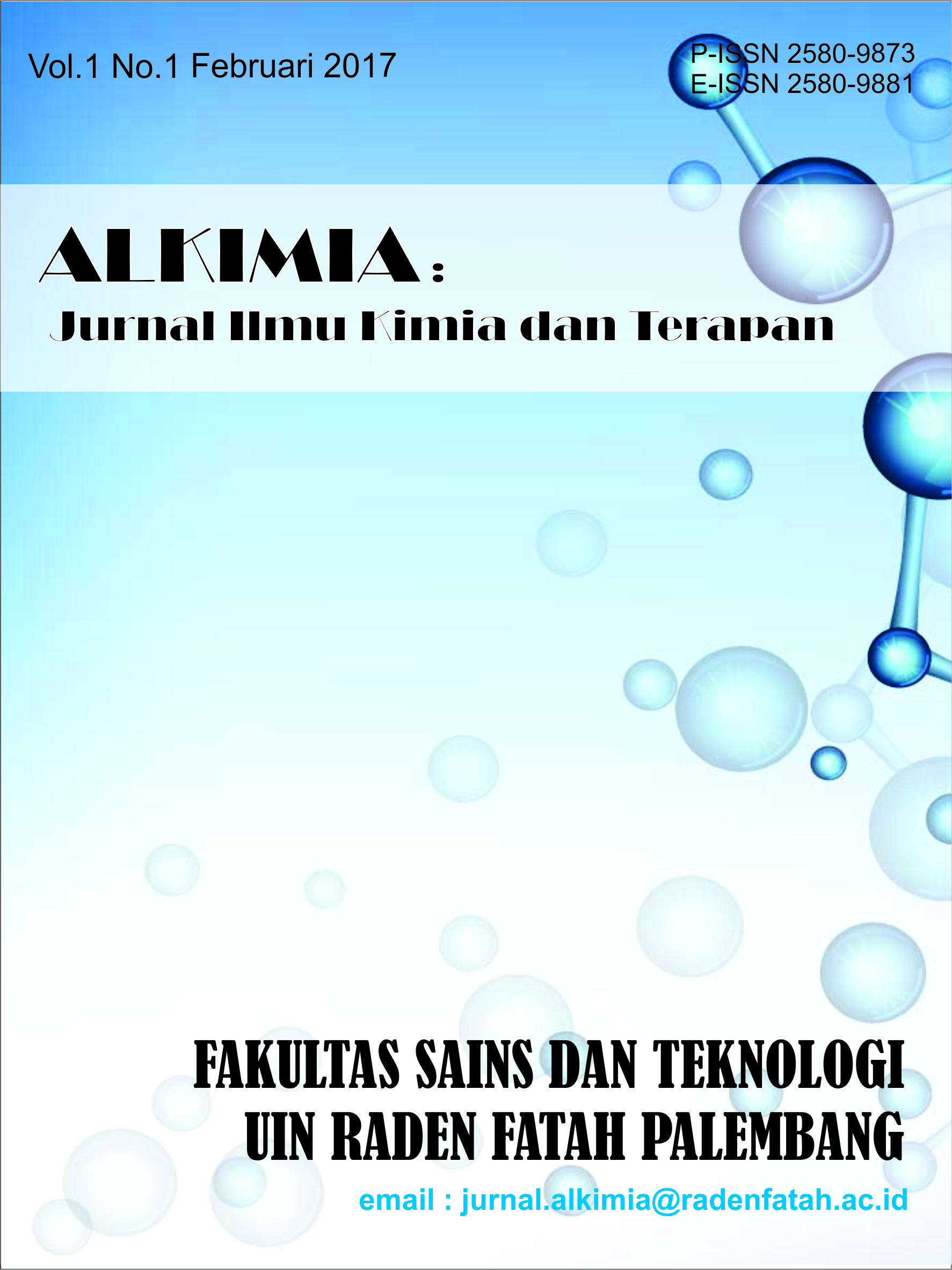Determination of Chemical Compounds and Antibacterial Activity in Turmeric Leaves (Curcuma Longa Linn)
DOI:
https://doi.org/10.19109/h66sar87Abstract
The use of synthetic antibiotics in medicine has encountered widespread resistance, prompting the development of new drugs from herbal plants. Herbal plants have the potential to become a new alternative to antibiotics. Turmeric is a plant that is widely used as a traditional medicine. Turmeric contains many secondary metabolites such as alkaloids, triterpenoids, flavonoids, tannins, and polyphenols, making it a potential traditional medicine, especially as an antibiotic. This research method aims to determine the chemical content of turmeric and determine its antibacterial activity. The research method involved extracting turmeric leaves with methanol, identifying the compounds using TLC, FT-IR, and GC-MS, and then testing their antibacterial activity. The results of TLC, FT-IR, and GC-MS measurements showed that the most abundant chemical compound in turmeric leaves was phytol. The results of the antibacterial activity inhibition of turmeric leaf extract showed that the methanol extract of turmeric leaves inhibited S. aureus and E. coli bacteria with values of 7.07 mm and 6.93 mm, respectively. This experiment indicates that the methanol extract of turmeric leaves has moderate antibacterial potential against S. aureus and E. coli bacteria.
References
A. Anjarwati, V. R. Nazillah, M. U. Alfaruqi, N. A. Wijaya, V. Volvariella, And I. S. Volvacea, “Diseminasi Dampak Pencemaran Lingkungan Bagi Kesehatan Di Sdn Sukabumi 2 Kota Probolinggo”.
S. H. A. Lau And H. Herman, “Studi Perbandingan Tingkat Pengetahuan Masyarakat Tentang Obat Herbal Dan Obat Sintetik Di Campagayya Kelurahan Panaikang Kota Makassar,” Jurnal Farmasi Sandi Karsa, Vol. 5, No. 1, Pp. 33–37, 2019.
T. Suprihatin, S. Rahayu, M. Rifa, And S. Widyarti, “Buletin Anatomi Dan Fisiologi Volume 5 Nomor 1 Februari 2020 Senyawa Pada Serbuk Rimpang Kunyit (Curcuma Longa L.) Yang Berpotensi Sebagai Antioksidan Compounds In Turmeric Rhizome Powder (Curcuma Longa L.) Which Have Potential As Antioxidants.”
R. Febriawan, “Manfaat Senyawa Kurkumin Dalam Kunyit Pada Pasien Diare,” Jurnal Medika Hutama, Vol. 2, No. 01 Oktober, Pp. 255–260, 2020.
W. U. N. Nyoman, “Pemanfaatan Rimpang Kunyit Hitam (Curcuma Caesia Roxb.) Sebagai Obat Tradisional,” Emasains: Jurnal Edukasi Matematika Dan Sains, Vol. 11, No. 1, Pp. 54–62, 2022.
D. Meilani And S. Rahayu, “Formulasi Dan Evaluasi Sediaan Sabun Padat Antiseptik Ekstrak Etanol Daun Kunyit,” Jurnal Indah Sains Dan Klinis, Vol. 3, No. 1, Pp. 15–19, 2022.
F. T. Rawung, F. A. Karauwan, D. N. Pareta, And R. R. Palandi, “Uji Aktivitas Antibakteri Formulasi Sediaan Salep Ekstrak Daun Krisan Chrysanthemum Morifolium Terhadap Bakteri Staphylococcus Aureus,” Biofarmasetikal Tropis (The Tropical Journal Of Biopharmaceutical), Vol. 3, No. 2, Pp. 8–16, 2020.
A. Wilapangga And S. Syaputra, “Analisis Antibakteri Metode Agar Cakram Dan Uji Toksisitas Menggunakan Bslt (Brine Shrimp Lethality Test) Dari Ekstrak Metanol Daun Salam (Eugenia Polyantha),” Indonesian Journal Of Biotechnology And Biodiversity, Vol. 2, No. 2, Pp. 50–56, 2018.
S. B. Utomo, M. Fujiyanti, W. P. Lestari, And S. Mulyani, “Uji Aktivitas Antibakteri Senyawa C-4 Metoksifenilkaliks [4] Resorsinarena Termodifikasi Hexadecyltrimethylammonium-Bromide Terhadap Bakteri Staphylococcus Aureus Dan Escherichia Coli,” Jurnal Kimia Dan Pendidikan Kimia, Vol. 3, No. 3, Pp. 109–209, 2018.
A. Dyera Forestryana, “Phytochemical Screenings And Thin Layer Chromatography Analysis Of Ethanol Extract Jeruju Leaf (Hydrolea Spinosa L.),” Jurnal Ilmiah Farmako Bahari, Vol. 11, No. 2, P. 120, 2020.
U. F. Fadillah, E. Hambali, And M. Muslich, “Identifikasi Senyawa Aktif Ekstrak Daun Pulutan (Urena Lobata L) Dengan Gc-Ms: Identification Of Active Compound In Pulutan (Urena Lobata L) Leaf Extract Using Gc-Ms,” Jurnal Sains Dan Kesehatan, Vol. 2, No. 3, Pp. 217–221, 2020.
A. Irawan, M. Ulfah, And N. S. Haerani, “Uji Aktivitas Antibakteri Ekstrak Etanolik Kulit Buah Salak Pondoh (Salacca Zalacca (Gaert.) Voss) Terhadap Bakteri Propionibacterium Acnes Dan Pseudomonas Aeruginosa,” Dalton: Jurnal Pendidikan Kimia Dan Ilmu Kimia, Vol. 7, No. 1, Pp. 9–17, 2024.
F. L. Allo, L. Febrina, And L. Rijai, “Aktivitas Antibakteri Sediaan Sabun Cair Berbahan Aktif Ekstrak Etanol Daun Karamunting (Melastoma Malabathricum),” In Proceeding Of Mulawarman Pharmaceuticals Conferences, 2015, Pp. 142–149.
S. Syachriyani, F. Firmansyah, And S. Al Qadri, “Uji Aktivitas Ekstrak Kombinasi Daun Sirih Merah (Piper Crocatum) Dan Daun Beluntas (Pluchea Indica L.) Terhadap Pertumbuhan Candida Albicans,” Fito Medicine: Journal Pharmacy And Sciences, Vol. 13, No. 1, Pp. 25–31, 2021.
Downloads
Published
Issue
Section
License
Copyright (c) 2023 Leni Legasari, Destriani Ningsih

This work is licensed under a Creative Commons Attribution-ShareAlike 4.0 International License.
- The author saves the copyright and gives the journal simultaneously with the license under Creative Commons Attribution License which permits other people to share the work by stating that it is firstly published in this journal.
- The author can post their work in an institutional repository or publish it in a book by by stating that it is firstly published in this journal.
- The author is allowed to post their work online (for instance, in an institutional repository or their own website) before and during the process of delivery. (see Open Access Effect).







.png)




